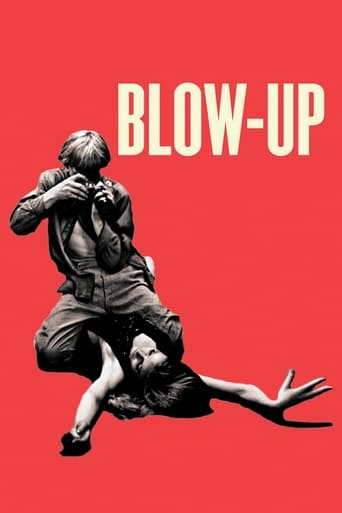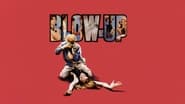Ken Anderson
Don't waste 2 hours of your life on this pretentios arty-fart CRAP. Typical Antonioni, there IS a plot but it only takes up 15 minutes with the rest simply padded out by a series of totally unrelated meaningless scenes.
Not much more to be said really apart from a message to those who pretend to see merit in this sort of nonsense - "the King isn't wearing any clothes"
ReasonablePiper
This movie barely has a narrative and is in no way a mystery-thriller. It's at all about a photographer trying to solve a murder he accidentally shot proof of. The murder doesn't happen until halfway in, he doesn't realize it until even later, he makes no attempt at solving it, it's never solved, and apparently it may have never even happened.It opens and closes with a crowd. At the beginning, a crowd of young people runs through the streets cheering. They contrast strongly with everyone else, all of whom walk silently, detached even. A few of them stop at Thomas' car to ask for money. He happily gives them a bill. Later, they put a sign in his car. He makes no attempt to stop them but does nothing to help either; the wind soon blows it out. At the end, they run down the streets cheering until two of them walk onto a tennis court. They are mimes, and they mime playing tennis. The rest of the small crowd is silent, and a few of them appear to be mimes too. Thomas watches from outside the fence, away from the crowd. Eventually one of the mimes hits the ball out of the court. Thomas hesitates, and the mime points to the imaginary ball. Thomas walks over to it, sets his camera down, picks the ball up, and throws it back to them. He grabs his camera and walks away. He is small and alone, surrounded by bright green grass. The crowd at the Yardbirds' concert is much different. They sit in silence while the band plays "Stroll On," which is "Train Kept a Rollin'" but with different lyrics. Only a few in the crowd dance. Jeff Beck breaks his guitar and throws the neck into the audience, and now they come alive. Thomas fights for the neck and is chased out of the building. No one follows him out, and he discards it on the sidewalk. Another man picks it up, then too throws it away.Other peculiar things happen. At the beginning, a model says she's leaving for Paris, and when Thomas finds her at the end and she's still in London, she says she's in Paris. I doubt the weed she's smoking makes her that confused. Thomas says he would be free if only he had more money, yet he drives around in a Rolls Royce. Is this a comment on insatiable greed? Who is murdered, and by whom? Why? Did the girl have anything to do with it? Did the murder even happen? The only thing I saw to suggest that it was all in his mind is the end tennis match. At the very end he hears real rackets hitting a real ball, even though there are none. I don't know what any of this means, but I wouldn't mind watching it again to try and figure it out.The cinematography was frequently beautiful. Maybe the story makes sense once I understand the hidden meaning, or maybe it's empty. Either way, I wish the story at least made sense on the surface. It never bored me, but nothing ever grabbed me either. Still, I feel like I missed a lot, so it warrants a second watch.
classicsoncall
OK, is it a mesmerizing and influential piece of cinematic art, or a pretentious pile of deep doo-doo? I'm coming down on the poopy side myself. I can read all the intellectual arguments one can make for this film, but if I have to have it explained to me, and STILL don't understand what the heck was going on, then the picture is a failure, at least for this viewer. Director Antonioni might have signaled his elaborate scheme by having one of the characters state at one point - "It's like finding a clue in a detective story". Oh yeah, well there's all sorts of clues going on, but they don't lead to anything. The corpse in the park should have been one of the biggies, come to think of it, but then it disappeared. Try explaining that one to the cops who come calling. But the cops never did come calling. Oh brother. With a little effort this picture could have worked as a spaghetti Western because it had a man with no name as the lead character (how you get Thomas out of it is another one of those mysteries). The piece de resistance for me was when what's his name and the mime troupe watched the invisible tennis ball go back and forth, and they did it all in coordination! Even Jeff Beck and Jimmy Page ought be embarrassed by this flick, and if they're not, they should be. Where's Clapton when you really needed him?
Pookie Mahdis
I read the Mad Magazine parody called "Throwup"which was probably back in 1967. Yesterday I finally saw the movie, less than 50 years later. All I recall from the parody were the black circles under the protagonist's eyes. I see value in this movie from a historical perspective as it shows what people were impressed with back then. Twiggy was a popular model and was called that name because she set a new standard of what models should look like (twigs). Two weeks ago, I watched Marilyn Monroe in Niagara and felt that I learnt more about a view of the times that I did from watching Blowup. I think what I gained by watching Blowup, I could have obtained by watching a 10 minute clip. I have not seen Ben Hur as an example of a movie that should be higher on my list than Blowup.






